Mana Ihori
Difference Vector Equalization for Robust Fine-tuning of Vision-Language Models
Nov 13, 2025Abstract:Contrastive pre-trained vision-language models, such as CLIP, demonstrate strong generalization abilities in zero-shot classification by leveraging embeddings extracted from image and text encoders. This paper aims to robustly fine-tune these vision-language models on in-distribution (ID) data without compromising their generalization abilities in out-of-distribution (OOD) and zero-shot settings. Current robust fine-tuning methods tackle this challenge by reusing contrastive learning, which was used in pre-training, for fine-tuning. However, we found that these methods distort the geometric structure of the embeddings, which plays a crucial role in the generalization of vision-language models, resulting in limited OOD and zero-shot performance. To address this, we propose Difference Vector Equalization (DiVE), which preserves the geometric structure during fine-tuning. The idea behind DiVE is to constrain difference vectors, each of which is obtained by subtracting the embeddings extracted from the pre-trained and fine-tuning models for the same data sample. By constraining the difference vectors to be equal across various data samples, we effectively preserve the geometric structure. Therefore, we introduce two losses: average vector loss (AVL) and pairwise vector loss (PVL). AVL preserves the geometric structure globally by constraining difference vectors to be equal to their weighted average. PVL preserves the geometric structure locally by ensuring a consistent multimodal alignment. Our experiments demonstrate that DiVE effectively preserves the geometric structure, achieving strong results across ID, OOD, and zero-shot metrics.
Joint Modeling of Big Five and HEXACO for Multimodal Apparent Personality-trait Recognition
Oct 16, 2025Abstract:This paper proposes a joint modeling method of the Big Five, which has long been studied, and HEXACO, which has recently attracted attention in psychology, for automatically recognizing apparent personality traits from multimodal human behavior. Most previous studies have used the Big Five for multimodal apparent personality-trait recognition. However, no study has focused on apparent HEXACO which can evaluate an Honesty-Humility trait related to displaced aggression and vengefulness, social-dominance orientation, etc. In addition, the relationships between the Big Five and HEXACO when modeled by machine learning have not been clarified. We expect awareness of multimodal human behavior to improve by considering these relationships. The key advance of our proposed method is to optimize jointly recognizing the Big Five and HEXACO. Experiments using a self-introduction video dataset demonstrate that the proposed method can effectively recognize the Big Five and HEXACO.
Few-shot Personalization via In-Context Learning for Speech Emotion Recognition based on Speech-Language Model
Sep 10, 2025


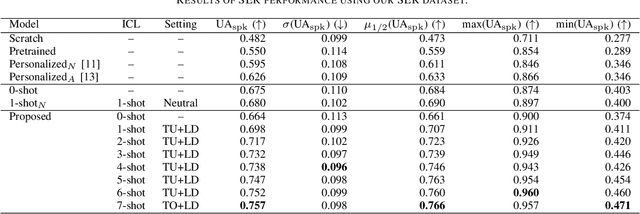
Abstract:This paper proposes a personalization method for speech emotion recognition (SER) through in-context learning (ICL). Since the expression of emotions varies from person to person, speaker-specific adaptation is crucial for improving the SER performance. Conventional SER methods have been personalized using emotional utterances of a target speaker, but it is often difficult to prepare utterances corresponding to all emotion labels in advance. Our idea to overcome this difficulty is to obtain speaker characteristics by conditioning a few emotional utterances of the target speaker in ICL-based inference. ICL is a method to perform unseen tasks by conditioning a few input-output examples through inference in large language models (LLMs). We meta-train a speech-language model extended from the LLM to learn how to perform personalized SER via ICL. Experimental results using our newly collected SER dataset demonstrate that the proposed method outperforms conventional methods.
End-to-End Joint Target and Non-Target Speakers ASR
Jun 04, 2023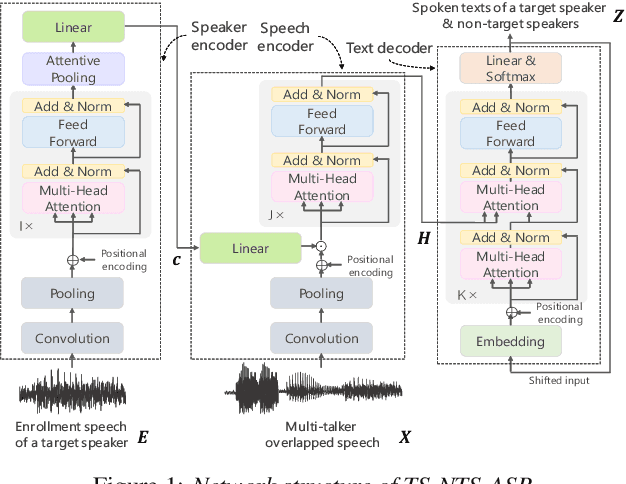


Abstract:This paper proposes a novel automatic speech recognition (ASR) system that can transcribe individual speaker's speech while identifying whether they are target or non-target speakers from multi-talker overlapped speech. Target-speaker ASR systems are a promising way to only transcribe a target speaker's speech by enrolling the target speaker's information. However, in conversational ASR applications, transcribing both the target speaker's speech and non-target speakers' ones is often required to understand interactive information. To naturally consider both target and non-target speakers in a single ASR model, our idea is to extend autoregressive modeling-based multi-talker ASR systems to utilize the enrollment speech of the target speaker. Our proposed ASR is performed by recursively generating both textual tokens and tokens that represent target or non-target speakers. Our experiments demonstrate the effectiveness of our proposed method.
Downstream Task Agnostic Speech Enhancement with Self-Supervised Representation Loss
May 24, 2023Abstract:Self-supervised learning (SSL) is the latest breakthrough in speech processing, especially for label-scarce downstream tasks by leveraging massive unlabeled audio data. The noise robustness of the SSL is one of the important challenges to expanding its application. We can use speech enhancement (SE) to tackle this issue. However, the mismatch between the SE model and SSL models potentially limits its effect. In this work, we propose a new SE training criterion that minimizes the distance between clean and enhanced signals in the feature representation of the SSL model to alleviate the mismatch. We expect that the loss in the SSL domain could guide SE training to preserve or enhance various levels of characteristics of the speech signals that may be required for high-level downstream tasks. Experiments show that our proposal improves the performance of an SE and SSL pipeline on five downstream tasks with noisy input while maintaining the SE performance.
Strategies to Improve Robustness of Target Speech Extraction to Enrollment Variations
Jun 16, 2022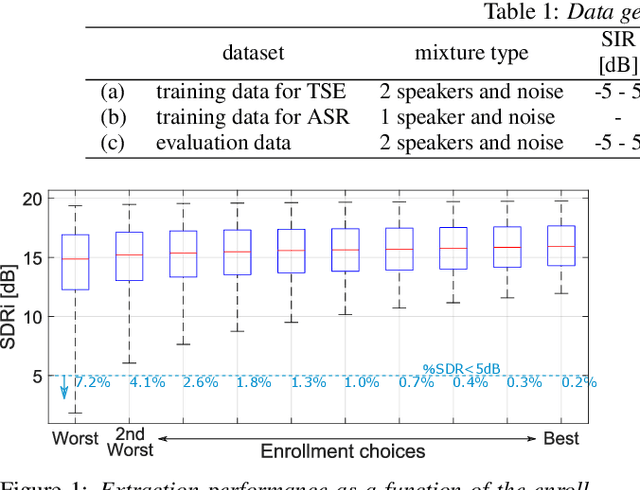
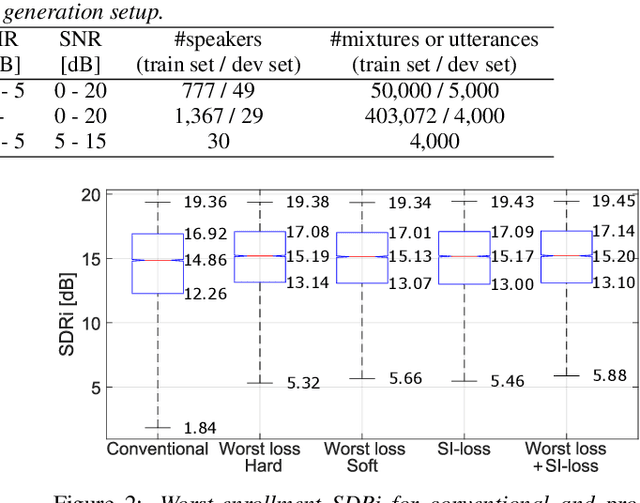

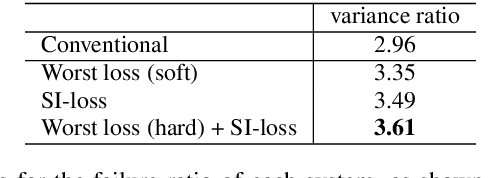
Abstract:Target speech extraction is a technique to extract the target speaker's voice from mixture signals using a pre-recorded enrollment utterance that characterize the voice characteristics of the target speaker. One major difficulty of target speech extraction lies in handling variability in ``intra-speaker'' characteristics, i.e., characteristics mismatch between target speech and an enrollment utterance. While most conventional approaches focus on improving {\it average performance} given a set of enrollment utterances, here we propose to guarantee the {\it worst performance}, which we believe is of great practical importance. In this work, we propose an evaluation metric called worst-enrollment source-to-distortion ratio (SDR) to quantitatively measure the robustness towards enrollment variations. We also introduce a novel training scheme that aims at directly optimizing the worst-case performance by focusing on training with difficult enrollment cases where extraction does not perform well. In addition, we investigate the effectiveness of auxiliary speaker identification loss (SI-loss) as another way to improve robustness over enrollments. Experimental validation reveals the effectiveness of both worst-enrollment target training and SI-loss training to improve robustness against enrollment variations, by increasing speaker discriminability.
Utilizing Resource-Rich Language Datasets for End-to-End Scene Text Recognition in Resource-Poor Languages
Nov 24, 2021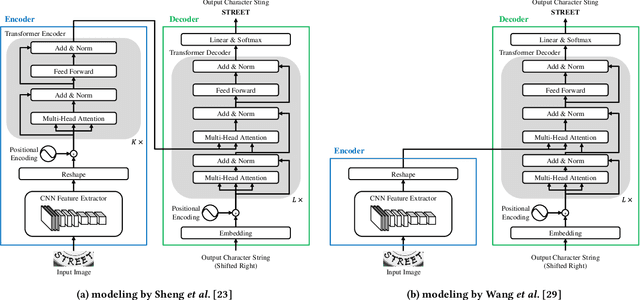
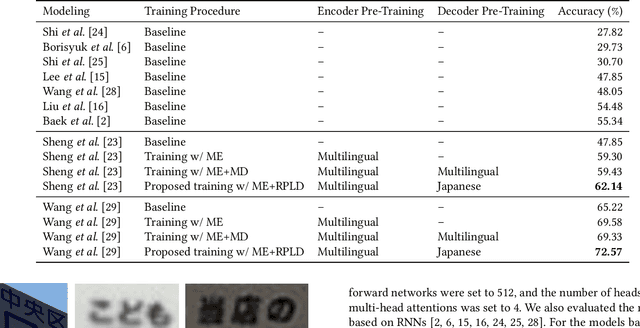
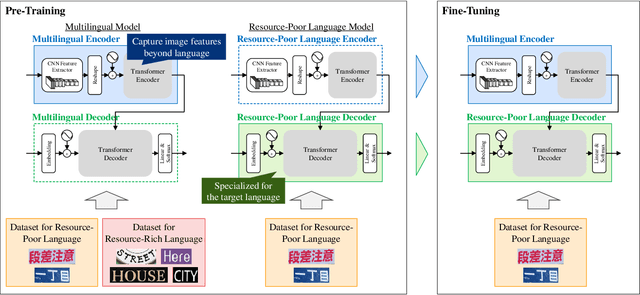
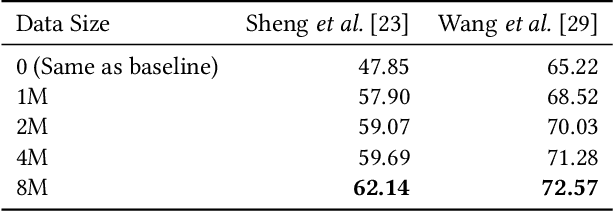
Abstract:This paper presents a novel training method for end-to-end scene text recognition. End-to-end scene text recognition offers high recognition accuracy, especially when using the encoder-decoder model based on Transformer. To train a highly accurate end-to-end model, we need to prepare a large image-to-text paired dataset for the target language. However, it is difficult to collect this data, especially for resource-poor languages. To overcome this difficulty, our proposed method utilizes well-prepared large datasets in resource-rich languages such as English, to train the resource-poor encoder-decoder model. Our key idea is to build a model in which the encoder reflects knowledge of multiple languages while the decoder specializes in knowledge of just the resource-poor language. To this end, the proposed method pre-trains the encoder by using a multilingual dataset that combines the resource-poor language's dataset and the resource-rich language's dataset to learn language-invariant knowledge for scene text recognition. The proposed method also pre-trains the decoder by using the resource-poor language's dataset to make the decoder better suited to the resource-poor language. Experiments on Japanese scene text recognition using a small, publicly available dataset demonstrate the effectiveness of the proposed method.
Hierarchical Knowledge Distillation for Dialogue Sequence Labeling
Nov 22, 2021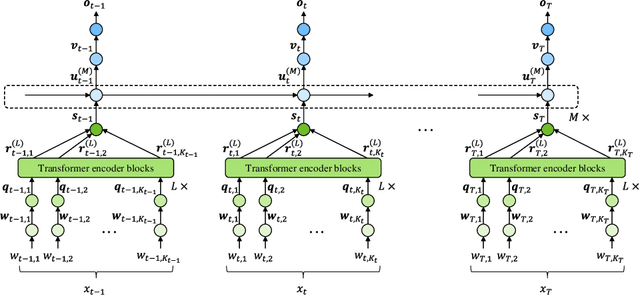
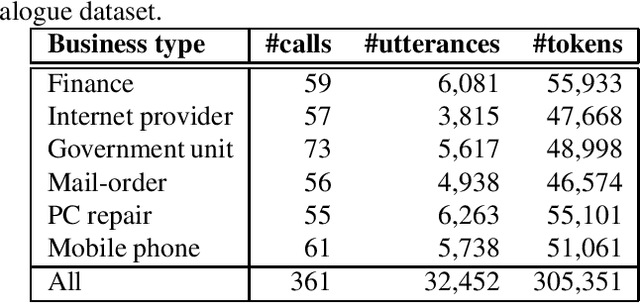
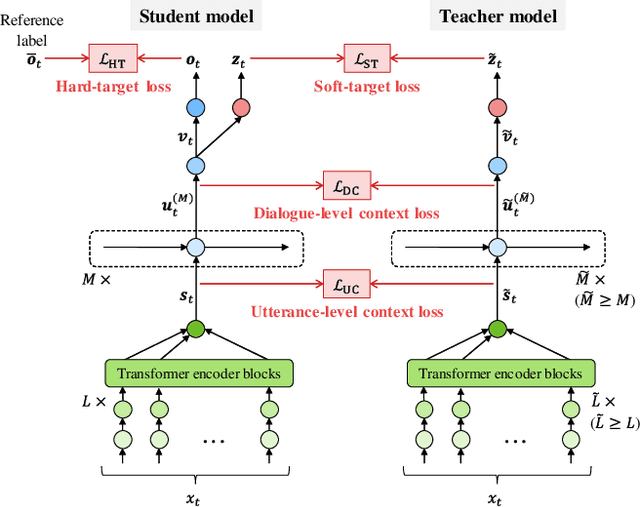

Abstract:This paper presents a novel knowledge distillation method for dialogue sequence labeling. Dialogue sequence labeling is a supervised learning task that estimates labels for each utterance in the target dialogue document, and is useful for many applications such as dialogue act estimation. Accurate labeling is often realized by a hierarchically-structured large model consisting of utterance-level and dialogue-level networks that capture the contexts within an utterance and between utterances, respectively. However, due to its large model size, such a model cannot be deployed on resource-constrained devices. To overcome this difficulty, we focus on knowledge distillation which trains a small model by distilling the knowledge of a large and high performance teacher model. Our key idea is to distill the knowledge while keeping the complex contexts captured by the teacher model. To this end, the proposed method, hierarchical knowledge distillation, trains the small model by distilling not only the probability distribution of the label classification, but also the knowledge of utterance-level and dialogue-level contexts trained in the teacher model by training the model to mimic the teacher model's output in each level. Experiments on dialogue act estimation and call scene segmentation demonstrate the effectiveness of the proposed method.
End-to-End Rich Transcription-Style Automatic Speech Recognition with Semi-Supervised Learning
Jul 07, 2021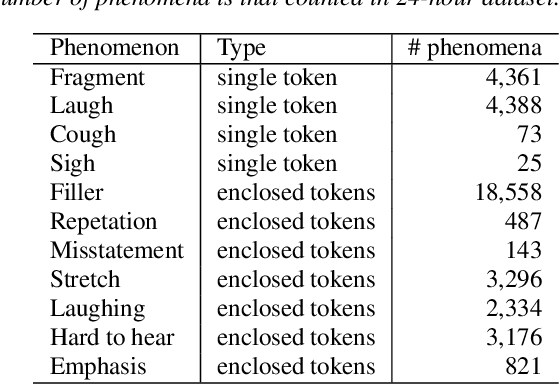
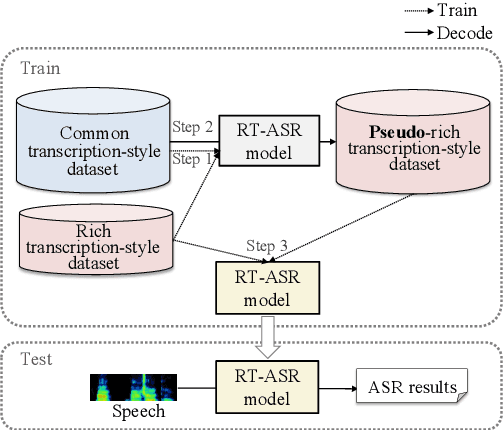
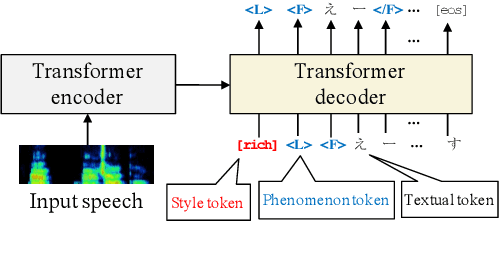
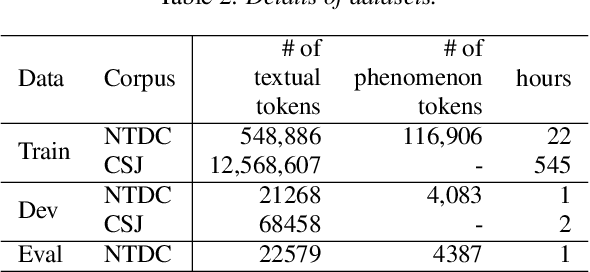
Abstract:We propose a semi-supervised learning method for building end-to-end rich transcription-style automatic speech recognition (RT-ASR) systems from small-scale rich transcription-style and large-scale common transcription-style datasets. In spontaneous speech tasks, various speech phenomena such as fillers, word fragments, laughter and coughs, etc. are often included. While common transcriptions do not give special awareness to these phenomena, rich transcriptions explicitly convert them into special phenomenon tokens as well as textual tokens. In previous studies, the textual and phenomenon tokens were simultaneously estimated in an end-to-end manner. However, it is difficult to build accurate RT-ASR systems because large-scale rich transcription-style datasets are often unavailable. To solve this problem, our training method uses a limited rich transcription-style dataset and common transcription-style dataset simultaneously. The Key process in our semi-supervised learning is to convert the common transcription-style dataset into a pseudo-rich transcription-style dataset. To this end, we introduce style tokens which control phenomenon tokens are generated or not into transformer-based autoregressive modeling. We use this modeling for generating the pseudo-rich transcription-style datasets and for building RT-ASR system from the pseudo and original datasets. Our experiments on spontaneous ASR tasks showed the effectiveness of the proposed method.
Cross-Modal Transformer-Based Neural Correction Models for Automatic Speech Recognition
Jul 04, 2021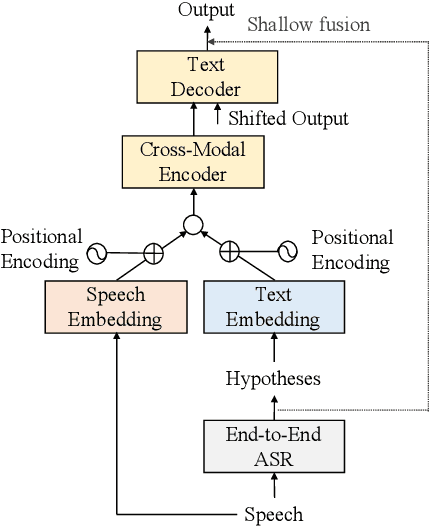
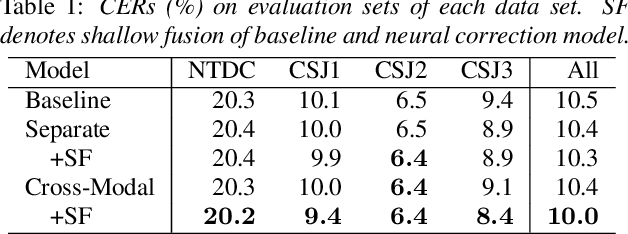
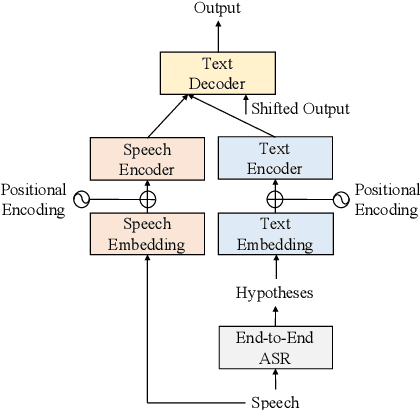
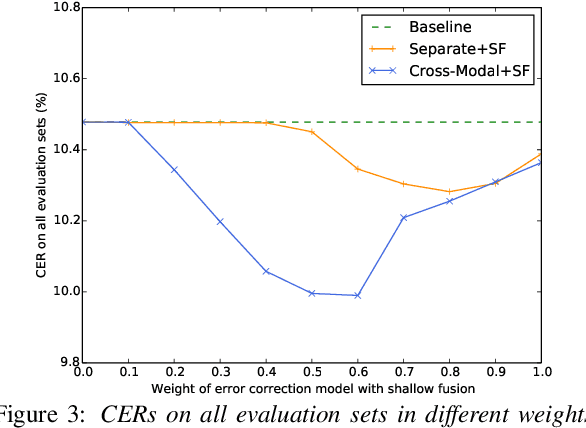
Abstract:We propose a cross-modal transformer-based neural correction models that refines the output of an automatic speech recognition (ASR) system so as to exclude ASR errors. Generally, neural correction models are composed of encoder-decoder networks, which can directly model sequence-to-sequence mapping problems. The most successful method is to use both input speech and its ASR output text as the input contexts for the encoder-decoder networks. However, the conventional method cannot take into account the relationships between these two different modal inputs because the input contexts are separately encoded for each modal. To effectively leverage the correlated information between the two different modal inputs, our proposed models encode two different contexts jointly on the basis of cross-modal self-attention using a transformer. We expect that cross-modal self-attention can effectively capture the relationships between two different modals for refining ASR hypotheses. We also introduce a shallow fusion technique to efficiently integrate the first-pass ASR model and our proposed neural correction model. Experiments on Japanese natural language ASR tasks demonstrated that our proposed models achieve better ASR performance than conventional neural correction models.
 Add to Chrome
Add to Chrome Add to Firefox
Add to Firefox Add to Edge
Add to Edge